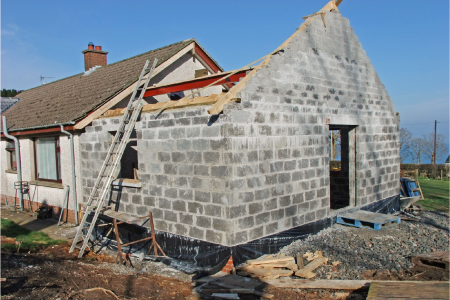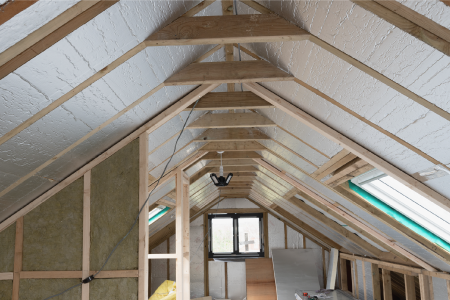Building an Extension Checklist: SAM's Extension Planner
Planning and executing an extension can be rewarding but complex. You will benefit from more space and, hopefully, an increase in your property's value, but have to contend with the time it takes to complete the work, potential issues with local planning officers, and underbudgeting.
Before getting ahead of yourself, you set clear goals for the project, understand planning restrictions, and create a realistic budget with a buffer just in case. By doing this, you can lay a solid foundation for your extension both literally and figuratively.
SAM's extension checklist
Click below to download our checklist PDF for building an extension.
Planning your extension
Having a clear vision of what you want to achieve with your extension is crucial. Do you want to gain more space, increase the value of your property, or make better use of the current floor space? For example, if you want to create a home office, you might prioritise soundproofing and privacy.
Check your contract and terms and conditions with your mortgage lender. Many mortgages will have a condition that you need lender permission before undertaking building work. If so, contact them and get permission.
It's important to contact your local planning authority to understand the specific rules and restrictions that might apply to your property. Common restrictions include height limits, roof pitch matching (for two-storey extensions), and boundary proximity.
Budgeting to build and extend
Unexpected costs can arise, so including a buffer or contingency fund is important. You need to outline a rough budget before you contact builders, so research online to compare prices, material options, and professional fees for architects, surveyors, engineers, or consultants.
Site assessment for a ground floor extension
Your property and the land it sits on have characteristics which must be taken into account:
- Different soil types can affect the foundation stability and construction process. For example, clay soil might require additional structural support due to its tendency to expand and contract with changes in moisture content.
- If there are any trees on your property, it's best to check with your local authority if there are any preservation orders or certain rules on cutting them down.
- Check flood maps for a history of flooding on your property or order a Flood Risk Report and consider taking out extra insurance if you are in a higher-risk area.
You may consider getting a site appraisal from a planning consultant before instructing an architect or structural engineer to draw up designs and plans.
Utilities and services
Gas, electricity, and sewage lines could disrupt your extension construction. For example, underground pipes or cables might need to be relocated, or telephone lines might need to be raised. You should contact the relevant utility companies to obtain necessary permits and coordinate with your work.
If your land runs over public sewers, you must contact the local water authority before work begins. If there is a shared sewer within 3 metres of the extension, a 'Build Over Agreement' is required.
Find out where your sewer line runs to avoid building within 3 metres. Ordered immediately, and the water board will confirm delivery time. Includes:
- Mains Water.
- Foul Water.
- Surface Water Sewer.
- Sewer Pipe Within Boundary.
- Water Pipe Within Boundary.
Neighbour relations
Open communication is essential with your neighbours throughout the extension building process to help avoid potential conflicts. How will the work affect their property? There might be temporary arrangements like moving fence panels or even using their land for short-term storage, so it's best to cooperate with them. Make sure your extension doesn't make your property a 'flying freehold' either.
Types of building extensions
Single-storey
Generally easier overall to plan and execute as the structural engineering is less; you won't need to support another floor on top of an extension. However, if a load-bearing wall is part of the extension work, a structural engineer is essential.
A basic single-storey extension can set you back around £48,000. If you're looking for a larger extension, you could spend up to £120,000. Roughly 10-20% of the budget is likely to be allocated to professional fees, such as planning permission applications, architects, or structural engineers.
A house extension typically adds between 10-20% to a property's value.
Depending on the size and scope of the project, an average single-storey extension can take between 2-4 months to complete.
Common uses for single-story extensions include:
- Creating additional bedrooms.
- Expanding the kitchen or dining area.
- Adding a home office or study.
- Creating a playroom for children.
Double-storey
A double-storey extension will be harder to plan and execute because of the structural implications of having to support a floor.
Costs for a double-storey extension whether a side, front, or wraparound could set you back around £100,000. Construction can take between 2-4 months, but planning could take anywhere from a few weeks to several months.
This can be a great way to increase living space, especially if you need more bedrooms and bathrooms, or want to increase the overall value of your property.
Loft conversion
A loft conversion can add living space to your home without extending outwards. It involves converting the attic space into a habitable room such as a home office or an additional bedroom.
The average cost for a loft conversion in the UK ranges from £27,000 to £75,000 depending on the type and size of the conversion.
Not only will you gain extra space, but it could also add up to 20% to your property's value.
Design and pre-construction
Once you have a handle on your goals, budget, and site conditions it's time to focus on the design and execution of your extension.
Do you need planning permission?
You make a planning application online through the Planning Portal. Every local authority in England and Wales accepts online planning applications through this portal.
You can instruct an architect or a structural engineer to draw up the plans. For smaller builds, you may even get an experienced builder to help you with your application.
The majority of planning applications cost a fee. There are some exclusions such as for listed buildings and for demolition in a conservation area, where a fee is not required.
Payment is required upfront before a decision is provided. If the local authority refuses the planning application then there is no refund.
Most extensions will need building regulations approval. Make sure to apply to your local building control before starting the project. Failure to comply with building regulations could reduce your property's value or you could be made liable to knock it down.
Building regulations are designed to ensure new building works meet health, safety, welfare, convenience, and sustainability standards. They relate to the specifics of how a building should be constructed, unlike planning permission which is about whether development should go ahead.




What are the National Requirements for a planning application?
- The standard application form.
- Locational plan.
- Site or Block plan.
- Ownership certificate.
- Agricultural holdings certificate.
- Design and access statement.
You can choose to provide a 'paper' planning application and you can download a printable form by clicking here.
Architectural design
Hiring a professional architect can provide valuable expertise and guidance throughout the design process. They can help you create a space that meets your needs and complements the existing style of your home.
However, not all extensions need an architect; for most small extensions, you can use a structural engineer instead. They're more affordable and will still make sure that the plans and designs are structurally sound and building regulations-compliant.
Consider the aesthetic and practical impacts the extension will have on the existing property. For example, if the home is already not well-insulated or thermally efficient, this will need to be upgraded when the extension is added.
If you intend to keep costs down, choose a simple square or rectangular shape for the extension. Designs with more complicated roof structures or lots of glass will be more expensive.
- Layout: How will the extension connect to the existing property? What is the best arrangement for rooms and spaces? Decide how you want to access the extension from the existing property - seamless or defined separation?
- Style: Do you want the extension to match the existing style of your home, or do you prefer a different aesthetic?
- Functionality: What specific purposes will the extension serve? Consider natural light, ventilation, and accessibility. Be sure to include roof lights, sun tunnels, or larger windows in the design to prevent it from being too dark.
- Planning regulations: Ensure your design complies with local planning regulations regarding building heights, setbacks, and other restrictions.
Glazing to square footage ratios - if you're extending an exterior wall, the same number of windows will not produce the same amount of light as before because the square footage has increased. Aim for approximately 25% window to square footage.


Prefabricated home extensions
You could use an off-site construction system where the majority of the work is done in a factory and then delivered to the building site.
These extensions are popular among people who need a quick way to add more space to their home. While spending less time on site is appealing, it comes with a higher cost; you'll pay the premium for factory manufacture and delivery.
Transporting the prefabricated extension to its destination requires careful planning, consent, and approval. You may need to temporarily close a road to allow a crane to access the site, so you'll have to obtain planning permission from the local authority.
Permitted development
Planning permission isn't always required so it is important to check to see if the work you are planning falls under what is called "Permitted Development Rights". Single-storey extensions might not need planning permission which could reduce your administrative costs.
Permitted development rights allow certain types of extensions and alterations to be carried out without full planning permission. These rights are outlined in the The Town and Country Planning (General Permitted Development) (England) Order 2015.
If you're unsure whether your proposed extension qualifies for permitted development, it's advisable to consult with your local planning authority or a planning professional.
Community Infrastructure Levy (CIL) on extensions over 100m
CIL is a charge levied by local councils on new developments (extensions over 100 square metres) to fund infrastructure improvements such as roads, schools, and parks. In some cases, you may be eligible for exemptions or reductions in CIL payments, such as for affordable housing, self-build projects, or extensions to existing dwellings.
Householder Applications
The planning application fee for alterations/extensions to a single dwellinghouse, including works within the boundary is £258 and the local planning office has 8 weeks to decide.
Construction and completion - final stages of extension build
Project Management
Decide whether you want to manage the project yourself, hire a professional project manager, or delegate management to the main contractor. The right approach will depend on the project's size, scope, and style. Take into account weather conditions, material availability, and potential delays.
Speak with at least four to six contractors informally to brief them on the project and get a rough idea of costs. Shortlist the best three for price and quality and send them a pack of documents which includes the legal framework, designs, drawings, specifications, and the job timescale.
Quotes, proposals, and contracts
Review their quotes and proposals thoroughly to compare prices, services, reputation, and experience. Be sure to ask questions about anything you aren't sure about. The main contractor and Project Manager should be provided with a schedule of works and a specification document, otherwise, the contractor will assume their own specification and this could cause costs to rise.
Check if the main contractor is part of the Federation of Master Builders (FMB); members must be vetted and pass an independent inspection process to join.
Once you've picked your builder, it's time to sign the contract. Top tip: sign a contract that includes staged payments instead of one lump sum at the beginning.


Can I build my own extension?
If you're skilled enough, doing a large portion of the build yourself could reduce project costs by as much as 25%. In a self-build extension, you'd still have to use trades for key structural work, but general labouring, landscaping, decorating, and tiling can be done if you're skilled enough.
Beware that if the work isn't done to a high standard, it could reduce your property's value. If it isn't building regulations-compliant, you might be held liable to knock the extension down.
You'll need to either live on-site or off-site during the construction. If you're on-site, you can oversee and monitor the work without finding temporary accommodation, but there's a noise disruption and mess everywhere.
If you leave the property vacant during construction, you will need unoccupied buildings insurance. Contact your existing insurer to see what coverage they can provide for this.
Am I eligible for VAT Relief?
Certain types of extension work on listed buildings or conversions of existing dwellings to change the number of units can be eligible for VAT relief. Even buildings that have been empty for at least two years could be eligible, so it's best to do your research to see if you can claim back expenses.
Important: You will always need listed building consent for extensions. It's a criminal offence to alter a listed building without approval. The extension must respect the character, appearance, and history of the building. Therefore, work might take longer and cost more with specialist materials or building techniques.
Before installing furniture and other fixtures or fittings, note every defect you find such as cracks, gaps in sealant, electrical faults, or tiling mistakes. Check that the water and heating work properly too. These should be reported to the contractor to ensure it's promptly addressed.
Book a structural engineer
SAM's structural engineers are experienced in extension work, looking to ensure that anything planned to be built is of high standard and complies with building regulations.
Andrew started his career in 2000 working within conveyancing solicitor firms and grew hands-on knowledge of a wide variety of conveyancing challenges and solutions. After helping in excess of 50,000 clients in his career, he uses all this experience within his article writing for SAM, mainstream media and his self published book How to Buy a House Without Killing Anyone.
Caragh is an excellent writer and copy editor of books, news articles and editorials. She has written extensively for SAM for a variety of conveyancing, survey, property law and mortgage-related articles.










